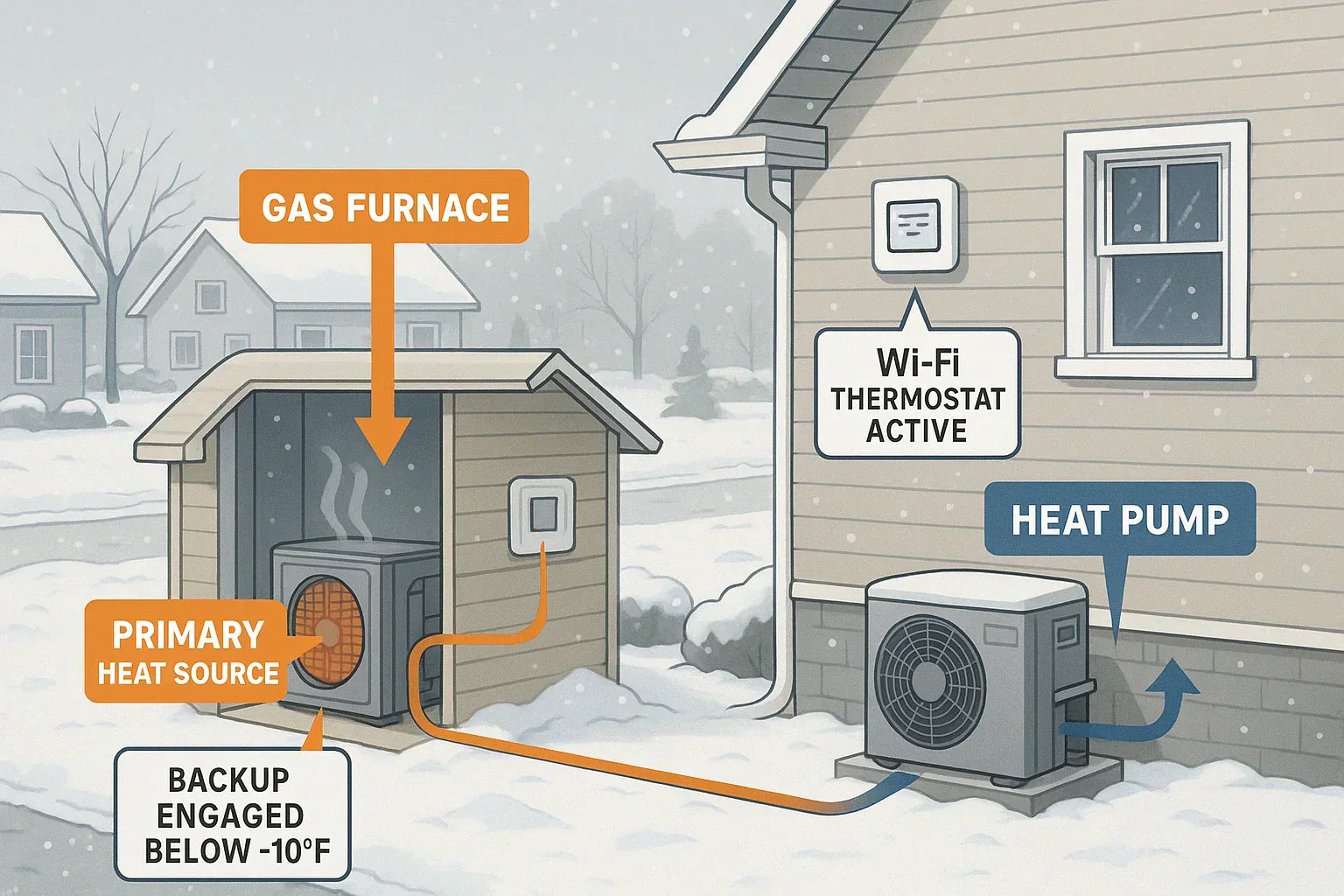Hi, I’m Alex Lane — your Home Comfort Advocate.
If you’ve been researching cold climate heat pumps, you’ve likely asked the question: Can they really keep your home warm and safe in extreme cold — like minus 20 degrees?
The short answer? Yes — if the system is properly designed and installed. But the real answer is a bit more nuanced. In this guide, we’ll look at performance data, manufacturer specs, real-world case studies, and expert recommendations to understand just how safe heat pumps are when the mercury drops.
Why Cold Weather Raises Safety Concerns
Unlike furnaces that generate heat through combustion, heat pumps move heat from outside to inside — which naturally raises questions about their ability to perform in sub-freezing temps.
When temps dip below 0°F, efficiency drops, run times increase, and the risk of equipment strain rises. That’s why it’s important to ask:
-
Will my heat pump keep up with demand?
-
What happens if it fails in the middle of a blizzard?
-
Are there safety protocols or backups built in?
Spoiler: Today’s cold climate heat pumps have answers for all of the above — if you choose the right system and size it correctly.
The Data: Performance at -5°F and Below
The U.S. Department of Energy’s Cold Climate Heat Pump Challenge has tested heat pumps in some of the nation’s harshest regions — including Alaska and Minnesota. Field-tested data showed that next-gen models from brands like Mitsubishi, Carrier, and Lennox continued operating at -13°F and beyond, maintaining indoor temps in real homes.
Key findings:
-
Coefficient of Performance (COP) remained above 1.5 in most models at -5°F.
-
Backup heat was rarely triggered unless temps dipped below design specs.
-
Inverter technology helped maintain comfort without frequent cycling.
And most importantly — no homeowners reported safety concerns due to heat pump failure when installed with proper sizing and backup.
How Today’s Heat Pumps Stay Safe and Reliable
1. Inverter Compressors Adapt in Real Time
Instead of running at full blast, inverter-driven compressors adjust output based on outdoor conditions. This helps maintain steady indoor temps without the peaks and valleys you get with older systems.
📘 Mitsubishi Inverter Heat Pump Technology
2. Defrost Mode Prevents Dangerous Ice Buildup
When outdoor coils freeze, the system automatically switches into defrost mode — temporarily reversing flow to melt ice and protect components.
📘 Carrier: How Defrost Mode Works
3. Backup Heat Options for Emergency Situations
Whether it’s an electric resistance strip, gas furnace (in dual-fuel setups), or hydronic loop — most systems include a secondary heat source that kicks in when temps fall below the heat pump’s design range.
If your home is in a northern climate, these backups are essential for peace of mind — not just performance.
📘 EPA Guide to HVAC Systems and IAQ
Real-World Case Study: Heat Pumps in the Midwest
One of the most rigorous testbeds is Minnesota — where winters regularly dip to -20°F.
In a field study led by the Center for Energy and Environment (CEE), homes equipped with cold climate heat pumps maintained safe indoor temperatures all season long. Even during a week-long polar vortex, properly designed systems paired with smart thermostats and backup heat handled the load.
📘 CEE Cold Climate Air Source Heat Pump Study
What Can Go Wrong? (And How to Prevent It)
While modern heat pumps are incredibly reliable, failure is still possible if your system isn’t properly:
-
Sized: Undersized units will run constantly and still fall short.
-
Installed: Poor airflow, refrigerant charge, or duct design can cripple performance.
-
Maintained: Dirty filters or blocked coils can reduce heat output and safety.
Looking for a safe heat pump setup tailored for compact or manufactured homes?
👉 Best Cold Climate Heat Pumps for Mobile Homes and Small Spaces
Homeowner Tips for Staying Safe in the Cold
Even if your system is designed for the cold, take these steps to protect your home:
✅ Schedule Pre-Winter Maintenance
Have a pro check refrigerant levels, inspect defrost mode, and confirm airflow.
✅ Use a Smart Thermostat
Set up alerts for temperature drops or short cycling. Learn more: ENERGY STAR Certified Connected Thermostats
✅ Have a Backup Plan
Know how to activate your auxiliary heat source if needed. If power outages are common in your area, consider pairing your system with a battery backup or generator.
Final Thoughts from Alex Lane
Cold climate heat pumps have earned their place as safe, efficient, and reliable heating options — even in extreme cold. But like any system, performance depends on proper planning.
Here’s how to stay safe:
-
Choose a unit designed for low-temp performance
-
Size your system with Manual J calculations
-
Build in backup heat for true peace of mind
-
Monitor system health through smart tools and apps
Ready to compare models and features across brands?
👉 Best Heat Pumps for Cold Climates in 2025
Stay warm, stay informed, and remember — the safest system is the one that’s designed with your winter in mind.
Alex Lane
Your Home Comfort Advocate







